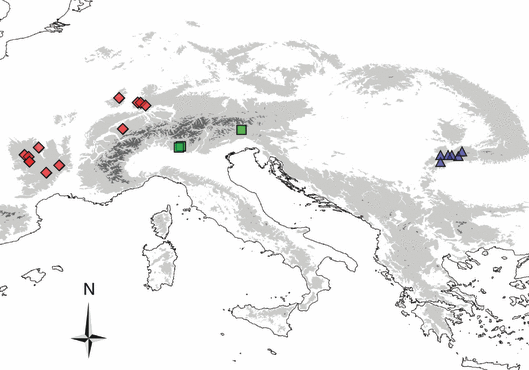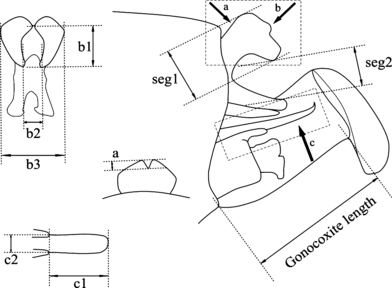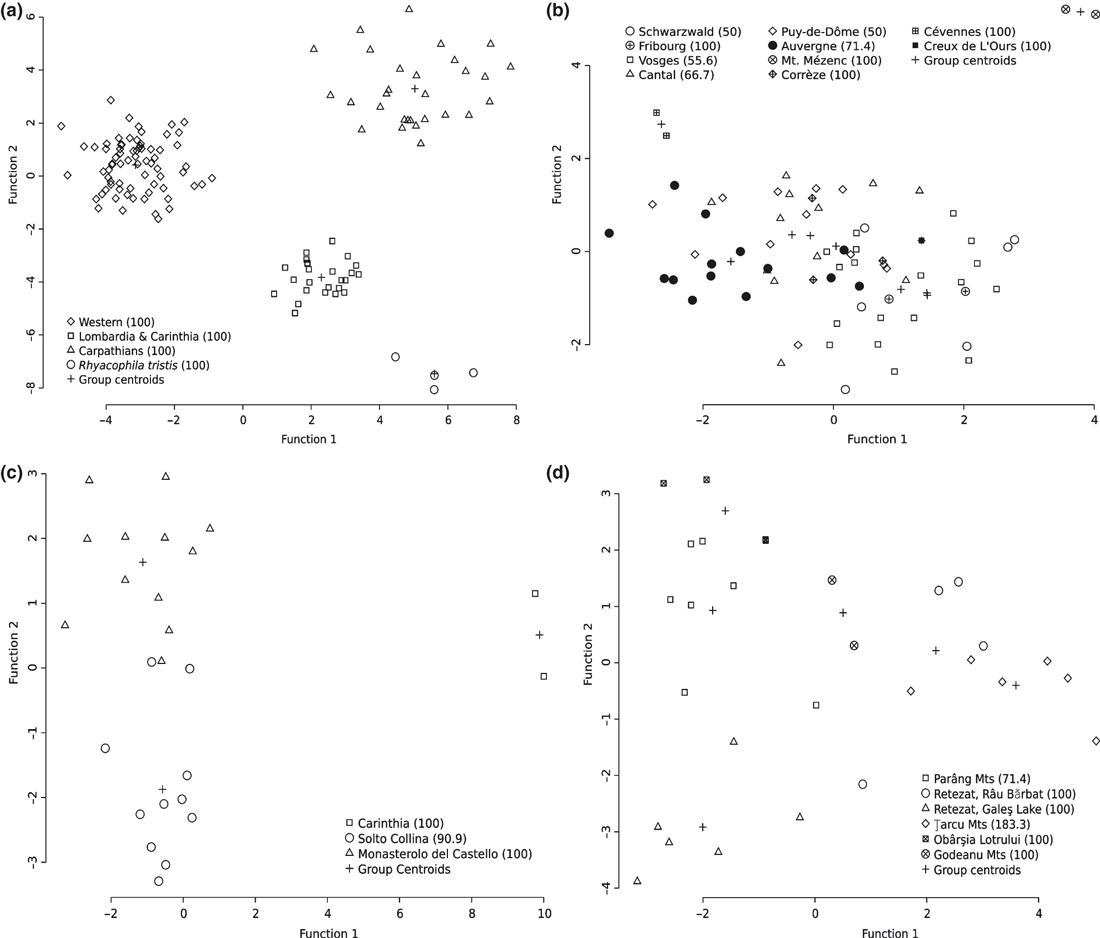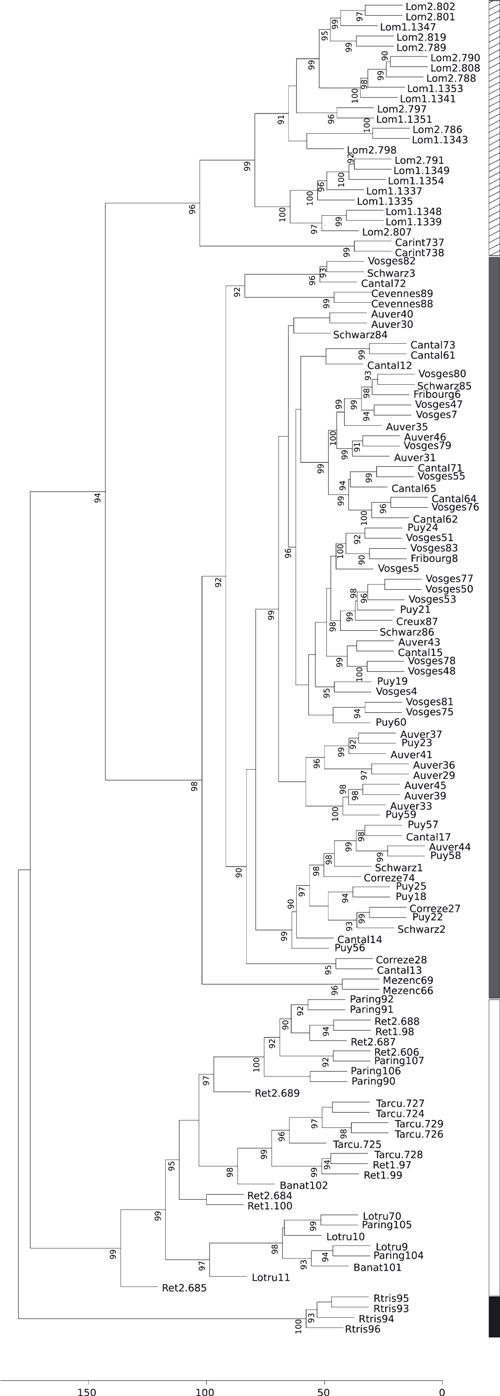Differentiation and speciation in mountain streams: a case study in the caddisfly Rhyacophila aquitanica (Trichoptera)
Differenzierung und Speziation in Bergbächen: eine Fallstudie an der Köcherfliege Rhyacophila aquitanica (Trichoptera)
Abstract
enFew studies have analysed the biogeography of mountain aquatic organisms, although this habitat provides stable conditions in which many species survived Pleistocene climatic oscillations, usually in the geographical vicinity of their present distribution ranges. The mountain caddisfly Rhyacophila aquitanica was selected as a model organism for this habitat type. Morphological measurements of genitalia and external characters of male individuals were obtained from almost the entire range of distribution of the species. Morphometric results were analysed by cluster analysis and multivariate statistics. Important differences were discovered among three population groups of R. aquitanica inhabiting different European mountain ranges: (i) mountain ranges north-west of the Alps (Massif Central, Vosges, Schwarzwald and Fribourg); (ii) the southern Alps (Lombardia and Carinthia); and (iii) the western part of the southern Carpathians. This divergence suggests a long-term isolation among these groups, which presumably took place long before the last Pleistocene glaciation, with no secondary contact among these populations. The differentiation centres of the southern Alps and Carpathian groups may have been mostly homotopic to their actual ranges, whereas the western group must have been distributed in the areas west or north-west of the Alps with secondary expansions and disjunctions.
Zusammenfassung
itDie Biogeographie von aquatischen Hochgebirgsarten wurde bisher nur in wenigen Fallstudien untersucht, obwohl dieser Habitattyp stabile Konditionen bietet, so dass in ihm viele Arten die pleistozänen Klimaschwankungen überdauern konnten, in vielen Fällen in geographischer Nachbarschaft zu ihren aktuellen Verbreitungen. Die Berg-Köcherfliege Rhyacophila aquitanica wurde als Modellorganismus für diesen Habitattyp ausgewählt. Morphologische Messungen der Genitalen und externe Charakteristika wurden von Männchen erhoben, die fast das gesamte Verbreitungsgebiet umfassen. Morphometrische Ergebnisse wurden durch Cluster-Analysen und multivariate Statistiken ausgewertet. Bedeutende Unterschiede wurden zwischen drei Gruppen von R. aquitanica festgestellt, welche unterschiedliche Berggebiete Europas besiedeln: (i) Berggebiete nordwestlich der Alpen (Massif Central, Vosges, Schwarzwald, Fribourg), (ii) die südlichen Alpen und (iii) der westliche Teil der Südkarpaten. Diese Divergenz macht eine lang anhaltende Isolation zwischen diesen Gruppen sehr wahrscheinlich, die lange vor der letzten pleistozänen Vereisungsphase eingesetzt haben muss ohne jeglichen sekundären Kontakt zwischen diesen Populationen. Die Differenzierungszentren der Südalpen- und der Karpatengruppe dürften weitgehend homotop mit ihren aktuellen Verbreitungen sein, wohingegen die westlichen Gruppe im Gebiet westlich oder nordwestlich der Alpen verbreitet gewesen sein muss, wobei es in dieser Gruppe mit hoher Wahrscheinlichkeit zu sekundären Expansionen und Disjunktionen kam.
Introduction
Much information is available on the biogeography of Europe generated by chorological, palaeontological, morphological and molecular analyses (e.g. Thienemann 1950; de Lattin 1967; Varga 1975, 1977; Williams 1987; Taberlet et al. 1998; Hewitt 1996, 2004), and the severe effects of the Pleistocene glaciations on almost all living organisms have been strongly emphasized (Williams et al. 1998; Jansson and Dynesius 2002; Reuther et al. 2007). As the majority of the present European species survived the glaciations in the southern parts of Europe, our knowledge of these so-called Mediterranean taxa is better than for the representatives of other biogeographical groups (Reinig 1937; de Lattin 1967; Taberlet et al. 1998; Hewitt 2000; Habel et al. 2005; Gómez and Lunt 2007; Schmitt and Krauss 2004; Gomez-Orellana et al. 2007). However, a significant number of taxa survived these climate shifts in extra-Mediterranean refugia (Aspöck 1979; Malicky et al. 1983; Stewart and Lister 2001; Schmitt et al. 2007). These continental and high mountain terrestrial species are currently under intensive study, but there is still much to be discovered about these groups (e.g. Schönswetter et al. 2003, 2004; Hewitt 2004; Schmitt and Hewitt 2004; Schönswetter and Tribsch 2005; Magri et al. 2006; Varga and Schmitt 2008).
While most existing surveys focus on terrestrial species, many groups of aquatic organisms are little studied and some data sets exist only for vertebrates: several fish (e.g. Bănărescu 1990; Bernatchez and Wilson 1998; Doadrio et al. 2002; Schreiber 2002; Pasko and Maslak 2003; Sonstebo et al. 2007) and, to a lesser extent, amphibian species (e.g. Szymura et al. 2000; Babik et al. 2003; García-París et al. 2003; Martínez-Solano et al. 2006). In particular, the inhabitants of fast-flowing mountain streams remain mostly unexplored, and these are grouped into the biome type termed the dinodal (Malicky 1983, 2000). Because of the buffering of temperature conditions in such aquatic systems, the influences of climatic oscillations were much less pronounced than in terrestrial habitats (Malicky 1983). It is argued that species inhabiting cold, fast-running mountain streams have therefore been able to survive glacial cycles in the vicinity of ice sheets, because fast-running waters provide stable and thus relatively long-term extrazonal environments for freshwater organisms (Malicky 1983; Pauls et al. 2006). Such organisms probably underwent relatively short-distance vertical migration, in contrast to the majority of terrestrial, or other continental aquatic species, with their large-scale distribution shifts.
Because the pattern of diversification of most species of freshwater invertebrates inhabiting the European mountain systems is still poorly understood, we selected a caddisfly species complex, the Rhyacophila tristis group, with special focus on Rhyacophila aquitanica (McLachlan, 1879). This species is a European endemic, distributed in the central-European mountains (for collecting localities, see Fig. 1 and Table S1).

Collecting localities of Rhyacophila aquitanica in the Massif Central, Vosges, Schwarzwald, Fribourg (diamonds), Lombardia and Carinthia (squares), SW Carpathians (triangles) for morphological measurements. Areas shaded with light and dark grey: 500 and 2000 m above sea level, respectively
The present analysis therefore contributes to a better understanding of the biogeography of such a typical element of the dinodal and helps to answer the following questions:
1 Do the various origins of R. aquitanica obtained from the Vosges, Massif Central, Schwarzwald, Fribourg, Carinthia, Lombardia, SW Carpathians differ significantly from each other so that geographically confined morphological entities can be discriminated among these mountain systems?
2 Do the different mountain systems harbour one or more endemic morphological entities, or does one single entity occur in more than one mountain system?
3 Is the amount of variance within morphological entities different among these entities?
4 Are populations within one geographical group morphologically distinct from each other?
5 What biogeographical and taxonomic implications can be drawn?
Materials and Methods
Study species
Rhyacophila aquitanica belongs to the tristis group of the Rhyacophila genus (Schmid 1970). The predatory larvae have no gills and inhabit fast-running mountain streams usually at altitudes between 500 and 2000 m (with some populations occurring also at altitudes as low as 150–200 m). The adult flight period is in July and August (Botoşaneanu 1957). The known distribution ranges are in the Massif Central, Vosges, Schwarzwald, Alps and the southern Carpathians, west from the Olt Valley (Botoşaneanu 1995), hereafter abbreviated as SW Carpathians.
Morphometrics
We analysed 126 male specimens of R. aquitanica and four specimens of R. tristis (Pictet, 1834). Females were excluded from this study as the majority of characters analysed are located on the male genitalia. The specimens of R. aquitanica originate from most parts of the known distribution range of the species (Table S1). Rhyacophila tristis specimens were used as an outgroup and were collected in the Carpathians. The majority of older museum specimens were dried individuals, while all specimens collected in 2006 and 2007 were preserved in 96% ethanol. Preliminary measurements were carried out to see if the strongly different methods of sample preservation (old dried specimens versus fresh specimens killed in ethanol) had adverse effects on the shape or size of investigated characters. Based on the results, it is assumed that the different preservation methods have not biased the results of the morphological measurements.
We measured two body characters: distance between the paired ocelli and length of the single spur on the first tibia, and nine genitalic characters (Fig. 2, terminology based on Schmid 1970; Kumanski 1987): length of gonocoxite, ventral view; seg1 – height of dorsal branch of 10th segment, lateral view; seg2 – distance between dorsal and ventral branches of 10th segment, lateral view; a – depth of opening on 10th segment from viewpoint a; b1 – length of opening on 10th segment from viewpoint b; b2 – width of opening on 10th segment from viewpoint b; b3 – width of 10th segment from viewpoint b; c1 – distance between tip of large dorsal and reduced ventral supraphallic lobes; c2 – width of dorsal supraphallic lobe at tip of ventral lobes. Measurements were made using a stereomicroscope with a calibrated micrometer eyepiece. The genitalia of the individuals were macerated in 10% NaOH, then washed in water, dehydrated in 96% alcohol and examined for measurements on a bed of fine glass beads under glycerol.

Measured characters of the 10th abdominal segment and the phallic apparatus on the genitalia of Rhyacophila aquitanica
Statistical analyses

Results
All 11 variables analysed presented considerable variability. First, we showed that R. tristis differed significantly from R. aquitanica in seven of the variables analysed (spur length: p = 0.007, n = 129, χ2 = 7.184; gonocoxite length: p = 0.027, n = 130, χ2 = 4.904; b3: p = 0.038, n = 129, χ2 = 4.31; c1: p < 0.001, n = 130, χ2 = 11.624; c2: p < 0.001, n = 130, χ2 = 11.78; a: p = 0.029, n = 129, χ2 = 4.743; b1: p = 0.042, n = 129, χ2 = 4.146; the p-value points out the possibility that the observed difference is only accidental, maximum being p = 1). Second, the populations of R. aquitanica clearly expressed geographically localized variability and all measured variables showed highly significant differences among three geographic entities: western Europe, south-eastern Alps (Lombardia and Carinthia) as well as SW Carpathians (Table S2). Specimens of R. aquitanica from Lombardia and Carinthia were generally smaller than those from the Carpathians or from the Central Massif, Vosges, Schwarzwald, while the Carpathian specimens showed important differences in the structure of the 10th abdominal segment (based on these differences, the Carpathian populations were described as R. aquitanica carpathica by Botoşaneanu 1995).
The principal components analysis revealed 11 PCs; this suggests parameters other than body size are also involved in the diversification of the specimens. The discriminant analysis performed using the resulted PCs revealed clear divisions between the three geographically separated groups of R. aquitanica (Fig. 3a): (i) western Europe (Massif Central, Vosges, Schwarzwald and Fribourg), (ii) southern-eastern Alps (Lombardia and Carinthia) and (iii) SW Carpathians (Retezat, ?arcu, Parâng, Godeanu and Obârşia Lotrului); 100% of the cases were correctly classified. The first and second discriminant functions explain 92.1% of the total observed variance (59.9% and 32.2% respectively). The third function explaining 7.9% of the total variance also discriminated the four groups (based on 3D plotting of the three functions, figure not presented here). Distances of individuals from group centroids are significantly different among the three geographical entities (Kruskal–Wallis, p < 0.001, n = 126, χ2 = 74.719). Carpathian specimens are located at significantly larger distances from the group centroid than the western and southern Alpine populations (Behrens–Fisher test, p = 0.004, n = 101, S = 3.421 and p < 0.001, n = 54, S = 3.79 respectively), where no significant differences between the western European and southern Alpine populations were detected (p = 0.092, n = 97, S = −2.114).

Discriminant analyses based on morphometric measurements of specimens from western Europe, Lombardia–Carinthia and the Carpathians. Numbers in brackets indicate the per cent of cases correctly classified
The discriminant analysis does not reveal any further structure within the western European populations. In this group, specimens from the Massif Central, Vosges, Schwarzwald and Fribourg clustered at random and no structure at the population level was observed (Fig. 3b); only 65.3% of the western specimens were correctly classified.
By contrast, the south-eastern Alps and the SW Carpathian groups showed strong discriminating effects at the population level. In the SW Carpathians, 89.7% of the cases were correctly classified. Interestingly, even the two Retezat populations are quite well distinguished from each other (Fig. 3d). Lombardian and Carinthian populations are clearly distinguished, but there is also a remarkable level of differentiation between the two Lombardian populations, collected from almost neighbouring valleys (Fig. 3c); 96% of the cases were correctly classified.
The cluster analysis clearly separated the: (i) western-European, (ii) Lombardian–Carinthian; and (iii) Carpathian populations of R. aquitanica and R. tristis (Fig. 4).

Cluster analysis of individuals (Euclidean distance, average linkage), based on the 11 principal components. Numbers at nodes are AU bootstrap values above 90, calculated by running 100 000 iterations
Discussion
Based on the morphological characters analysed, R. aquitanica is split into three clearly differentiated groups in a distinct geographic pattern. Two of these entities are endemic to the southern Alps and the SW Carpathians, respectively, while the third is scattered over the Massif Central, the Vosges, the Schwarzwald and the canton Fribourg (CH). This suggests a long-term isolation among the groups investigated, differentiated at least at subspecific level (Botoşaneanu 1995), but possibly even at species level. In contrast to R. aquitanica carpathica (Botoşaneanu 1995), the Italian and Carinthian populations of R. aquitanica have never been distinguished from other R. aquitanica. In this survey, we found good morphological evidence which indicates that these entities are morphologically different from each other. More details on these differences are the object of another study. Most likely the centres of differentiation of these three groups have been located north-west of the Alps, south of the Alps and in the area of the SW Carpathians. The isolation of the populations in the southern Alps and the SW Carpathians presumably happened long before the Würm glaciation, while the populations in the western European mountain ranges were presumably isolated quite recently.
In the case of another mountain caddisfly, Drusus discolor (Rambur), Pauls et al. (2006) found strong evidence for completely interrupted gene flow between most mountain systems. The complete lack of a link between Carpathian and Alpine populations in these two caddisflies is an important difference from most terrestrial mountain species in which such a link is quite common (Varga and Schmitt 2008; Schmitt et al. 2008 with further references therein).
The levels of variance within the three morphological entities show important differences within the three morphological entities. Carpathian populations inhabiting only a small fraction of this mountain range present higher levels of variance than populations from the southern Alps and the western European mountain systems. Furthermore, the populations of the SW Carpathians and the southern Alps show population-specific morphological characteristics, while such structures are absent in the western group.
For these reasons, it is most likely that the Carpathian and southern Alps populations of R. aquitanica survived the glacial cycles in the vicinity of their present habitats, with moderate altitudinal shifts during cold and warm stages of the Pleistocene, accumulating population-specific differences. The much drier climate of the Carpathians during the cold periods, as water was trapped in large ice sheets (Reuther et al. 2007), further restricted the possible range for R. aquitanica, a species well adapted to cold and wet environments, but not to dry conditions. The situation was probably similar in the southern Alps. Therefore, the distribution of the single populations might have been rather patchy, thus restricting the exchange of individuals between populations, and enhancing a population-specific differentiation. For example, this is mirrored in the two populations sampled in the Retezat mountains and the two populations from the Lombardian Alps, which show remarkable morphological differentiation, even though they are not separated by present-day dispersal barriers.
More extended range shifts are likely in the western group, where the distribution was probably continuous during cold stages and only became fragmented during the warm interglacial periods. This led to recent separation (most probably post-Würmian) of the areas of distribution of various populations, without any morphological divergence among them.
The present study shows that the Quaternary history of mountain aquatic species might be different from those inhabiting terrestrial habitats, and also from continental / Mediterranean aquatic species (Hewitt 2004; Schmitt 2007). While the latter were usually able to perform large-scale range shifts during the climatic cycles, populations of mountain aquatic organisms were usually trapped in situ by the unfavourable climatic and hydrological conditions, with the result of more frequent divergence and speciation events in this biome.
Acknowledgements
The authors thank Lazare Botoşaneanu, Hans Malicky, Wolfram Graf, Marco Valle, Steffen Pauls, Andrea Sundermann, Omar Lodovici and Cristi Domşa for important specimens and useful ideas. We also thank the two anonymous referees for their help in improving the manuscript. Most of the western specimens of R. aquitanica were measured in the Natural History Museum, London, with the help of a SYNTHESYS grant of the European Union; some individuals were measured in the Senckenberg Museum with the aid of a Communitas travel grant. Field collections and laboratory work were partly financed by the 1342/2006 CNCSIS and 38/2007 TD-CNCSIS grants of the Romanian government. Miklós Bálint’s scholarship, which enabled the preparation of this paper, was generously provided by the DAAD of the German government.




